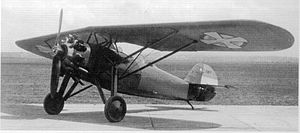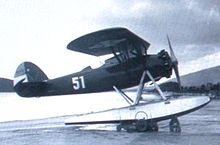Rogozarski PVT Video - Picture

|
|
Rogozarski PVT

Role: Advanced trainer
National origin: Yugoslavia
Manufacturer: Prva Srpska Fabrika Aeroplana Zivojin Rogozarski, Belgrade
Designer: R. Fizir; S. MilutinoviÄ; K. SivÄev and A.BiÄeviÄ
First flight: c.1934
Introduction: 1936
Retired: 1945
Status: inactive
Primary user: Yugoslav Royal Air Force
Number built: 61
The Rogozarski PVT ( transliterated as Rogozarski PWT in German and as Rogojarsky PVT in some older English sources) was a single-engined, two-seat parasol winged aircraft designed as an advanced and fighter trainer in Yugoslavia before World War II. Over 60 were built, serving with the Yugoslav Royal Air Force until the fall of Yugoslavia in 1941. After that, some PVTs were used by the newly formed Croatian Air Force, sometimes as ground attack aircraft.
Design and development
The Prva Srpska Fabrika Aeroplana Zivojin Rogozarski was the first Serbian aircraft manufacturer in Yugoslavia, founded in 1924. In about 1933 its team of Rudolf Fizir, Sima MilutinoviÄ, Kosta SivÄev and Adem BiÄeviÄ designed the PVT, a training aircraft with tandem open cockpits in an oval wooden monocoque fuselage. Its wooden, canvas covered wings were swept and parasol mounted well above the fuselage with pairs of lift struts to the lower fuselage and a central inverted V cabane. They carried long narrow chord ailerons, with prominent spades well clear of the upper surfaces.

Airplane Picture - Seaplane Rogozarski PVT-H (Kumbor 1938)
The PVT was powered by a 420 hp (313 kW) 7-cylinder radial Gnx“me-Rhx“ne 7K radial engine, housed with its cylinder heads exposed and driving a two-bladed propeller. The fixed, divided type undercarriage had on each side a main shock absorber leg, its upper end attached to a steel pyramid protruding from the mid-fuselage keeping the leg closer to the vertical whilst providing a wide track. Each wheel was connected to the lower fuselage with a swinging V-strut. A simple tail skid completed the undercarriage. The horizontal tail and fixed fin were both canvas covered wooden structures, though the moving surfaces, also canvas covered, had metal frames. The tailplane was strut braced to the fuselage from below and wire braced above to the fin. It carried elevators which were spade assisted like the ailerons but also horn balanced. The unbalanced rudder was broad and rounded.
Operational history
The PVT prototype probably first flew in 1934. An initial production batch of 20 aircraft was delivered to the YAF during 1936. Another 40 were delivered during 1938-9, of which the last 10 had fixed 7.7 mm (0.303 in) forward firing machine guns fitted and were powered by a licence built version of the Gnx“me-Rhx“ne 7K engine, the IAM K7. More PVTs were under construction at the time of the Italo-German invasion of Yugoslavia in April 1941. 15 PVTs captured by the Germans were presented to the newly formed Croatian Air Force. Later some of these were fitted with bomb racks and used as attack aircraft until 1945.
A few PVTs, designated PVT-H, (H-hidro) were configured as seaplanes on standard Edo (EDO Float Model 38) floats mounted on N-shaped struts. During 1938 and 1939, four PVT-H aircraft wee delivered to the Yugoslav Royal Navy.
Operators
Kingdom of Yugoslavia
Royal Yugoslav Air Force 61 aircraft
Croatia
Air Force of the Independent State of Croatia 14 ex-Royal Yugoslav Air Force
Specifications
Data from Grey 1938, p. 314-5c
General characteristics
Crew: 2
Length: 8.54 m (28 ft 0 in)
Wingspan: 11.20 m (36 ft 9 in)
Height: 2.81 m (9 ft 3 in)
Wing area: 22.1 m (238 sq ft)
Empty weight: 967 kg (2,132 lb)
Gross weight: 1,213 kg (2,674 lb)
Powerplant: 1 x Gnx“me-Rhx“ne 7K 7-cylinder radial, 310 kW (420 hp)
Performance
Maximum speed: 240 km/h (150 mph; 130 kn) at sea level
Service ceiling: 7,000 m (22,966 ft)
Rate of climb: 6.54 m/s (1,287 ft/min) to 2,000 m (6,562 ft)
Yugoslav Royal Air Force
Rogozarski AZR
Rogozarski SIM-Š„
Rogozarski R-100
Grey, C.G. (1972). Jane's All the World's Aircraft 1938. London: David & Charles. ISBN 0-7153-5734-4.
Rogozarski PVT Pictures
More airplane video.
Source: WikiPedia